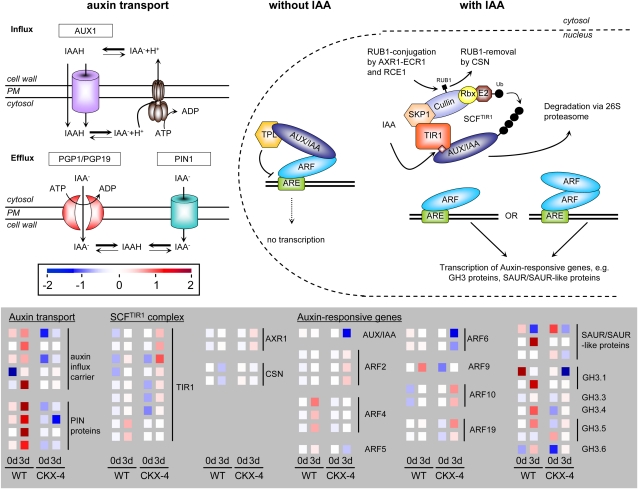Figure 13.
Expression of auxin transport and signaling genes in wild-type (WT) and CKX-4 tubers after GA3-mediated tuber sprouting. An overview of auxin transport proteins is shown on the left, and the auxin signaling pathway is shown on the right as derived from Arabidopsis (Mockaitis and Estelle, 2008; Weijers and Friml, 2009). Expression data of differentially expressed ESTs representing genes of auxin transport and signaling are shown in the gray panel. Color bars as displayed by the MapMan tool were copied to and aligned in Microsoft PowerPoint. The color scale above the panel indicates transcript levels, with red representing an increase and blue representing a decrease in transcript levels. The colors saturate at 4-fold change. Details on the assignment of individual POCI identifiers to genes shown are listed in Supplemental Table S3. Auxin transport: IAA is the most abundantly occurring auxin in nature. It can enter the cell in its protonated form either by diffusion through the plasma membrane or facilitated by AUX1 permeases. Inside the cell, IAAH is deprotonated and trapped due to the change in pH. Auxin efflux is performed by two types of transporters, PGP1/PGP19 ATP-binding cassette transporters and PIN proteins. PGP1/PGP19 usually has a nonpolar localization, whereas PIN proteins show a polar localization that determines the orientation of the auxin flow within the cell. Auxin signaling, without IAA: ARF transcription factors bind to auxin-responsive elements (AREs) in the promoters of auxin-responsive genes and interact with Aux/IAA proteins, which in turn recruit the transcriptional corepressor TPL to prevent gene expression. When accumulating in the nucleus, IAA binds to Aux/IAA proteins and the TIR1 subunit of the SCFTIR1 complex, targeting Aux/IAA for degradation via the 26S proteasome and releasing ARF transcription factors from inhibition. The activity of the SCRTIR1 complex can be regulated by the addition and removal of ubiquitin-like protein RUB1 through the action of conjugating (AXR1, RCE1, and ECR1) and deconjugating (CSN) enzymes. ARFs released from inhibition act as monomers or dimers to promote the expression of auxin-responsive genes (e.g. those coding for SAUR and GH3 proteins). AUX1, Auxin 1; AXR1, auxin-resistant 1; CSN, COP9 signalosome; ECR1, E1 C-terminal-related 1; PGP, P-glycoprotein; PIN, PIN-formed; PM, plasma membrane; RBX, RING box protein; RCE1, RUB1-conjugating enzyme; RUB1, related to ubiquitin; SCF complex, SKP1-cullin-F-box complex; SKP1, S-phase kinase-associated protein 1; TIR1, transport inhibitor response 1; TPL, topless; Ub, ubiquitin.

